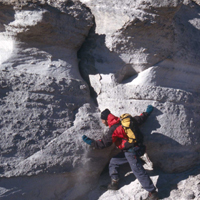
Polar Dinosaurs

Nunavut 2007 Home
Expedition Itinerary
Expedition Members
Polar Dinosaurs
Scientific Overview
Sponsorship
During the Mesozoic era (244 to 65 million years ago), the High Arctic was a very different place. At the beginning of the Triassic (248 to 206 million years ago) all the continents were assembled into a large super-continent near the equator called Pangaea. During this period, North America was moving from a position approximately 30 degrees further south than present to its current location, leading to a major difference, especially in the northern latitudes, in both temperature and photoperiod (Ash and Basinger 1991). Much of the continent was experiencing very warm, dry conditions, much like those of the American southwest today.
As time progressed, North America began to move further and further north. The Jurassic (200 to 144 million years ago) saw the climate become cooler and wetter, especially in the Arctic. However, while it was cooling, the average temperatures were much higher than today, and regions that are year-round permafrost today probably never dipped below freezing during this time. We know from some fragmentary evidence that at this time much of the Arctic Islands were part of a large, temperate rainforest, which probably supported a host of animals like lizards, amphibians and dinosaurs.
During the Cretaceous (144 to 65 million
years ago) global temperatures probably reached a maximum, with regions
in the Arctic possibly 20 to 30 degrees warmer on average compared to
today, with abundant precipitation and very little frost (Wolfe and
Upchurch 1987).
These warm temperatures gradually cooled off during most of the Tertiary (65 to 1.5 million years ago), yet still remained higher than today. During the Pliocene (5.3 to 1.8 million years ago) the temperatures were cooler than they had been 60 million years previous, but were still roughly 15°C warmer in Arctic regions than currently (Ballantyne et al. submitted).
![]()